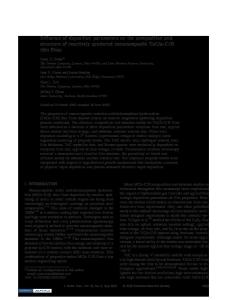Structure and Morphology of Reactively Sputtered In 0.9 Sn 0.1 O x Layers
- PDF / 3,453,734 Bytes
- 6 Pages / 612 x 792 pts (letter) Page_size
- 47 Downloads / 307 Views
Structure and Morphology of Reactively Sputtered In0.9Sn0.1Ox Layers R. Mientus1, I. Sieber, K.Ellmer Hahn-Meitner-Institut, dept. Solar Energetics, D-14109 Berlin, Glienicker Str. 100, Germany 1 Opto-Transmitter-Umweltschutz-Technologie e.V., D-12555 Berlin, Germany ABSTRACT In this work, the influence of the discharge parameter oxygen partial pressure during reactive magnetron sputtering on the structure and morphology of In0.9Sn0.1Ox films is investigated. The oxygen partial pressure was varied in order to deposit In0.9Sn0.1Ox films with 0 ≤ x ≤ 1.76. The composition x was measured by Rutherford backscattering (RBS). For low x values, these films are metallic and opaque, while at x ≈ 1.5 the layers exhibit good properties as transparent and conducting electrodes. Further increase in x leads to transparent insulating films. The morphology of the films, investigated by SEM, shows significant variations with the composition x. While the metallic films consist of coarse globular grains, made up of polycrystalline indium-tin, a small addition of oxygen leads to nearly amorphous metal-oxide mixtures with smooth surfaces. Around x ≈ 1.5 the films are polycrystalline with the cubic In2O3 bixbyite structure and show a resistivity minimum. The cross sectional morphology of these films exhibits a columnar structure of broad bundles (≈250 nm), composed of narrow needlelike crystallites of about 20 nm diameter. At very high oxygen partial pressures, the grain size decreases while the strain and the resistivity increase significantly. INTRODUCTION Tin-doped indium oxide (ITO) belongs to the material class of transparent conductive oxides (TCO) together with tin oxide (SnO2) and zinc oxide (ZnO) [1]. These materials are wide band gap semiconductors (band gap Eg>3.2 eV), which can be degenerately doped up to charge carrier concentrations of about 1021 cm-3, leading to resistivities in the range of 10-4 Ωcm. ITO is the material with the lowest resistivities achieved up to now (≈1.5.10-4 Ωcm) [2]. Therefore, it is used as transparent and conductive electrode layer for flat panel displays, based on liquid crystals, micro plasmas or light emitting polymers. Other applications are low emissivity coatings on glass, antistatic layers, heated windows or thin film solar cells. Magnetron sputtering from ceramic targets (for instance In2O390 wt%/SnO210 wt%) is widely used today as a deposition method for flat panel display electrodes. This method allows low deposition temperatures, which is due to the ion-assisted deposition during magnetron sputtering. Furthermore, this technique is very well suited for large area coatings [3]. Though many reports dealing with the preparation of ITO film can be found in literature, the current status in ITO and other TCO films has been achieved almost on a pure empirical basis. Besides the energy input into the growing film another influence from the plasma is very important for the ITO properties: the amount of reactive, i.e. atomic or excited oxygen, that leads to the oxidation of the metal atoms in the
Data Loading...










